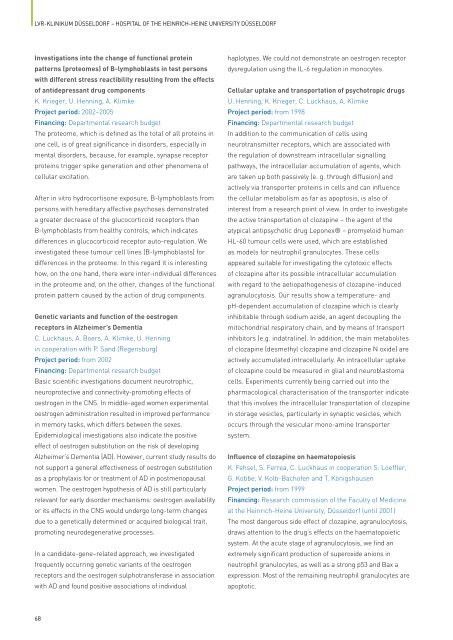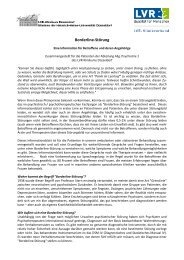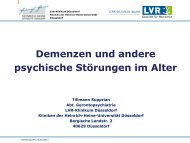LVR-Klinikum Düsseldorf Hospital of the Heinrich-Heine University ...
LVR-Klinikum Düsseldorf Hospital of the Heinrich-Heine University ...
LVR-Klinikum Düsseldorf Hospital of the Heinrich-Heine University ...
You also want an ePaper? Increase the reach of your titles
YUMPU automatically turns print PDFs into web optimized ePapers that Google loves.
<strong>LVR</strong>-KLINIKUM DÜsseLDORF – hOsPITaL OF The heINRIch-heINe UNIVeRsITY DÜsseLDORF<br />
Investigations into <strong>the</strong> change <strong>of</strong> functional protein<br />
patterns (proteomes) <strong>of</strong> B-lymphoblasts in test persons<br />
with different stress reactibility resulting from <strong>the</strong> effects<br />
<strong>of</strong> antidepressant drug components<br />
K. Krieger, U. Henning, A. Klimke<br />
Project period: 2002–2005<br />
Financing: Departmental research budget<br />
The proteome, which is defined as <strong>the</strong> total <strong>of</strong> all proteins in<br />
one cell, is <strong>of</strong> great significance in disorders, especially in<br />
mental disorders, because, for example, synapse receptor<br />
proteins trigger spike generation and o<strong>the</strong>r phenomena <strong>of</strong><br />
cellular excitation.<br />
After in vitro hydrocortisone exposure, B-lymphoblasts from<br />
persons with hereditary affective psychoses demonstrated<br />
a greater decrease <strong>of</strong> <strong>the</strong> glucocorticoid receptors than<br />
B-lymphoblasts from healthy controls, which indicates<br />
differences in glucocorticoid receptor auto-regulation. We<br />
investigated <strong>the</strong>se tumour cell lines (B-lymphoblasts) for<br />
differences in <strong>the</strong> proteome. In this regard it is interesting<br />
how, on <strong>the</strong> one hand, <strong>the</strong>re were inter-individual differences<br />
in <strong>the</strong> proteome and, on <strong>the</strong> o<strong>the</strong>r, changes <strong>of</strong> <strong>the</strong> functional<br />
protein pattern caused by <strong>the</strong> action <strong>of</strong> drug components.<br />
Genetic variants and function <strong>of</strong> <strong>the</strong> oestrogen<br />
receptors in Alzheimer’s Dementia<br />
C. Luckhaus, A. Boers, A. Klimke, U. Henning<br />
in cooperation with P. Sand (Regensburg)<br />
Project period: from 2002<br />
Financing: Departmental research budget<br />
Basic scientific investigations document neurotrophic,<br />
neuroprotective and connectivity-promoting effects <strong>of</strong><br />
oestrogen in <strong>the</strong> CNS. In middle-aged women experimental<br />
oestrogen administration resulted in improved performance<br />
in memory tasks, which differs between <strong>the</strong> sexes.<br />
Epidemiological investigations also indicate <strong>the</strong> positive<br />
effect <strong>of</strong> oestrogen substitution on <strong>the</strong> risk <strong>of</strong> developing<br />
Alzheimer’s Dementia (AD). However, current study results do<br />
not support a general effectiveness <strong>of</strong> oestrogen substitution<br />
as a prophylaxis for or treatment <strong>of</strong> AD in postmenopausal<br />
women. The oestrogen hypo<strong>the</strong>sis <strong>of</strong> AD is still particularly<br />
relevant for early disorder mechanisms: oestrogen availability<br />
or its effects in <strong>the</strong> CNS would undergo long-term changes<br />
due to a genetically determined or acquired biological trait,<br />
promoting neurodegenerative processes.<br />
In a candidate-gene–related approach, we investigated<br />
frequently occurring genetic variants <strong>of</strong> <strong>the</strong> oestrogen<br />
receptors and <strong>the</strong> oestrogen sulphotransferase in association<br />
with AD and found positive associations <strong>of</strong> individual<br />
68<br />
haplotypes. We could not demonstrate an oestrogen receptor<br />
dysregulation using <strong>the</strong> IL-6 regulation in monocytes.<br />
Cellular uptake and transportation <strong>of</strong> psychotropic drugs<br />
U. Henning, K. Krieger, C. Luckhaus, A. Klimke<br />
Project period: from 1998<br />
Financing: Departmental research budget<br />
In addition to <strong>the</strong> communication <strong>of</strong> cells using<br />
neurotransmitter receptors, which are associated with<br />
<strong>the</strong> regulation <strong>of</strong> downstream intracellular signalling<br />
pathways, <strong>the</strong> intracellular accumulation <strong>of</strong> agents, which<br />
are taken up both passively (e. g. through diffusion) and<br />
actively via transporter proteins in cells and can influence<br />
<strong>the</strong> cellular metabolism as far as apoptosis, is also <strong>of</strong><br />
interest from a research point <strong>of</strong> view. In order to investigate<br />
<strong>the</strong> active transportation <strong>of</strong> clozapine – <strong>the</strong> agent <strong>of</strong> <strong>the</strong><br />
atypical antipsychotic drug Leponex® – promyeloid human<br />
HL-60 tumour cells were used, which are established<br />
as models for neutrophil granulocytes. These cells<br />
appeared suitable for investigating <strong>the</strong> cytotoxic effects<br />
<strong>of</strong> clozapine after its possible intracellular accumulation<br />
with regard to <strong>the</strong> aetiopathogenesis <strong>of</strong> clozapine-induced<br />
agranulocytosis. Our results show a temperature- and<br />
pH-dependent accumulation <strong>of</strong> clozapine which is clearly<br />
inhibitable through sodium azide, an agent decoupling <strong>the</strong><br />
mitochondrial respiratory chain, and by means <strong>of</strong> transport<br />
inhibitors (e.g. indatraline). In addition, <strong>the</strong> main metabolites<br />
<strong>of</strong> clozapine (desmethyl clozapine and clozapine N oxide) are<br />
actively accumulated intracellularly. An intracellular uptake<br />
<strong>of</strong> clozapine could be measured in glial and neuroblastoma<br />
cells. Experiments currently being carried out into <strong>the</strong><br />
pharmacological characterisation <strong>of</strong> <strong>the</strong> transporter indicate<br />
that this involves <strong>the</strong> intracellular transportation <strong>of</strong> clozapine<br />
in storage vesicles, particularly in synaptic vesicles, which<br />
occurs through <strong>the</strong> vesicular mono-amine transporter<br />
system.<br />
Influence <strong>of</strong> clozapine on haematopoiesis<br />
K. Fehsel, S. Ferrea, C. Luckhaus in cooperation S. Loeffler,<br />
G. Kobbe, V. Kolb-Bach<strong>of</strong>en and T. Königshausen<br />
Project period: from 1999<br />
Financing: Research commission <strong>of</strong> <strong>the</strong> Faculty <strong>of</strong> Medicine<br />
at <strong>the</strong> <strong>Heinrich</strong>-<strong>Heine</strong> <strong>University</strong>, <strong>Düsseldorf</strong> (until 2001)<br />
The most dangerous side effect <strong>of</strong> clozapine, agranulocytosis,<br />
draws attention to <strong>the</strong> drug’s effects on <strong>the</strong> haematopoietic<br />
system. At <strong>the</strong> acute stage <strong>of</strong> agranulocytosis, we find an<br />
extremely significant production <strong>of</strong> superoxide anions in<br />
neutrophil granulocytes, as well as a strong p53 and Bax a<br />
expression. Most <strong>of</strong> <strong>the</strong> remaining neutrophil granulocytes are<br />
apoptotic.

















